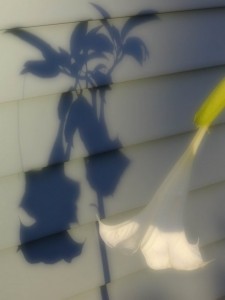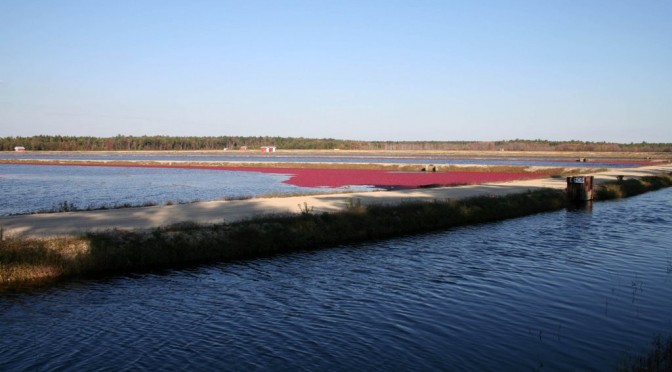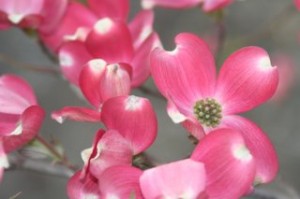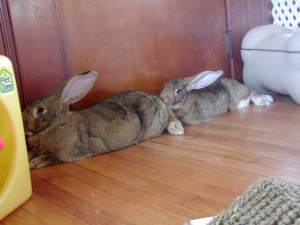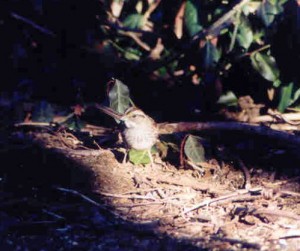 I sometimes think my husband gets a kick out of sending me to buy the biggest and heaviest tools as gifts for him. Very seldom am I sent to find anything that I can easily carry or wrap nicely.
I sometimes think my husband gets a kick out of sending me to buy the biggest and heaviest tools as gifts for him. Very seldom am I sent to find anything that I can easily carry or wrap nicely.
His birthday is this Sunday, and rather than totally spacing his birthday as I often do, I knew just what to buy for him this year because he kindly pointed it out to me on our last visit to Lowe’s to buy new blinds.
The object of his desire is that Bosch Power Box. I’m not exactly clear on what it does, besides that it plays music, stuff plugs into it, and you can drop it from a few stories up without breaking it. Most importantly, his friend Pete has one; I think that must be why he wants one. Toy envy.
It was light enough that I was able to carry it out of the store without any construction workers feeling sorry for me, but I don’t have a clue how I’ll wrap it.
I wonder if my husband feels as out of his element when shopping for gifts as I do. Does he roam around the bookstore or camera shop with no real idea what he’s buying, like I do when browsing the tool section? Does he wish that I liked jewelry or perfume or some other easy to purchase thing? What do wives buy for their husbands besides tools?
Monthly Archives: October 2006
10/19/06 Mid-week bunny fix
 I totally stole this pic from the October BunFun newsletter sent out by Leith Petwerks. I’m not sure which looks more annoyed at being a pumpkinhead – Patches or Flynn. Leith sells great bunny stuff, by the way!
I totally stole this pic from the October BunFun newsletter sent out by Leith Petwerks. I’m not sure which looks more annoyed at being a pumpkinhead – Patches or Flynn. Leith sells great bunny stuff, by the way!
Before first frost
Winter refugees
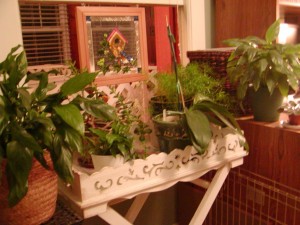 During the summer months my houseplants live outside on the screened patio; with the threatened frost this past weekend I brought them inside from their fair weather sojourn. The problem now is where to put them all. For the moment I’m keeping most of them in my office where they’ll be safe from marauding bunnies and clumsy dog tails. They’re crowded together on this little plant stand in front of the sort-of-south-facing window, up high enough that Peeper can’t reach them without really trying. I’ve found her once or twice atop my desk, so it’s possible.
During the summer months my houseplants live outside on the screened patio; with the threatened frost this past weekend I brought them inside from their fair weather sojourn. The problem now is where to put them all. For the moment I’m keeping most of them in my office where they’ll be safe from marauding bunnies and clumsy dog tails. They’re crowded together on this little plant stand in front of the sort-of-south-facing window, up high enough that Peeper can’t reach them without really trying. I’ve found her once or twice atop my desk, so it’s possible.
The Asparagus Fern in the back is my longest lived houseplant; I think I’ve had it for 3 or 4 summers now. I like to keep it out on the sunporch with the big bunnies, but it has grown considerably this summer and I found Boomer and Cricket doing some inspired pruning when I first brought it in and put it back in its usual spot. I have fairly good luck with Peace Lilies, so I keep quite a few. I can’t manage to make them bloom ever, but the foliage is pretty enough without flowers. They aren’t so happy spending the summers outside, as I can never seem to keep enough water on them. My jade plants do terrific out on the patio, though. Last year I took a few cuttings and was able to *trade* them with friends (I read that it’s bad luck to give Jades as gifts, so I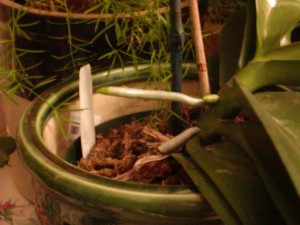 only trade them for cuttings of other plants. lol!)
only trade them for cuttings of other plants. lol!)
The orchid that I bought back in April is still alive and is sending out these funny things (pictured at right) that I’m not sure are roots or stalks that will bloom. I’m not sure what to do with them. Ideas anyone?
I like to have my houseplants back inside because it’s so much easier to care for them, but they do seem to suffer with the darker days and dry conditions inside the house.
More from the cranberry farms and bogs
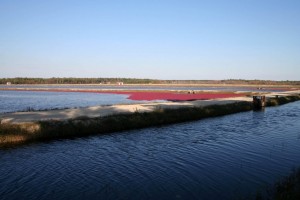 I’m including this photo of a commercial cranberry farm to give an idea of how large the operation is. In the immediate foreground is the canal that surrounds the bog, just visible to the right is a gate used to control water flow in and out of where the cranberries are grown and harvested. Elevated dikes surround each bog. I think most farms flood their fields prior to harvest and leave them that way during the winter freeze to protect the cranberry plants. Most, if not all of these *wet-harvested* cranberries are destined for the juice market and I believe that the farmers are part of a cooperative that produces for Ocean Spray.
I’m including this photo of a commercial cranberry farm to give an idea of how large the operation is. In the immediate foreground is the canal that surrounds the bog, just visible to the right is a gate used to control water flow in and out of where the cranberries are grown and harvested. Elevated dikes surround each bog. I think most farms flood their fields prior to harvest and leave them that way during the winter freeze to protect the cranberry plants. Most, if not all of these *wet-harvested* cranberries are destined for the juice market and I believe that the farmers are part of a cooperative that produces for Ocean Spray. 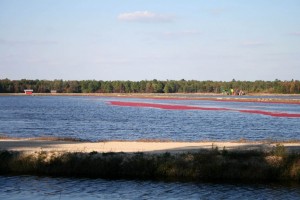 All of the equipment used in the harvest was at the far end of view, but if you use your imagination you can see that green machine with the yellow hose on it that is the *boom* used to corral the loose berries. I learned during the visit to Whitesbog Village that these booms were adapted from those used to clean up oil spills. It used to be that cranberries were harvested by people wading in the water and pushing the berries forward to a corner of the bog to be picked up on conveyor belts or the like, but the current method is much less labor-intensive. In the early days of cranberry farming, the berries were *dry harvested* by women and children walking the fields using metal or wooden scoops to pick the berries from the vines, much like blueberries, I guess.
All of the equipment used in the harvest was at the far end of view, but if you use your imagination you can see that green machine with the yellow hose on it that is the *boom* used to corral the loose berries. I learned during the visit to Whitesbog Village that these booms were adapted from those used to clean up oil spills. It used to be that cranberries were harvested by people wading in the water and pushing the berries forward to a corner of the bog to be picked up on conveyor belts or the like, but the current method is much less labor-intensive. In the early days of cranberry farming, the berries were *dry harvested* by women and children walking the fields using metal or wooden scoops to pick the berries from the vines, much like blueberries, I guess.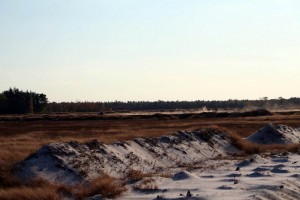 Back to the abandoned bogs at Whitesbog – I took this pic of a few yahoos on motorbikes riding across the sandy dikes that traverse the bogs.
Back to the abandoned bogs at Whitesbog – I took this pic of a few yahoos on motorbikes riding across the sandy dikes that traverse the bogs. 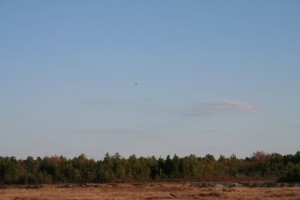 Here’s the bird pic of the day – that speck in the middle is a kestral forced to flight by the motorbikes. When I first arrived they were perched on the scrubby sand piles along the dike and would occasionally fly from their perches to hover over the brush below.
Here’s the bird pic of the day – that speck in the middle is a kestral forced to flight by the motorbikes. When I first arrived they were perched on the scrubby sand piles along the dike and would occasionally fly from their perches to hover over the brush below.
Postcards from a cranberry bog
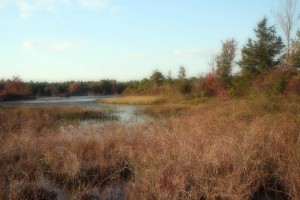 The *where we live* photo meme post that Laura at Vitamin Sea started a few weeks ago has me thinking like a tourist. Rather than staying home the past few Sundays (grading papers like a good teacher) I’ve been dreaming up places to visit that I usually just breeze past on my way to somewhere else. It’s been a good excuse to get a homebody like myself off my duff and keep the camera in good working order.
The *where we live* photo meme post that Laura at Vitamin Sea started a few weeks ago has me thinking like a tourist. Rather than staying home the past few Sundays (grading papers like a good teacher) I’ve been dreaming up places to visit that I usually just breeze past on my way to somewhere else. It’s been a good excuse to get a homebody like myself off my duff and keep the camera in good working order.
I’ve been very pleased with the complimentary comments posted here about the beauty of my home state; I understand that NJ is not often thought of as so picturesque. Most of my travels searching for photos have brought me to the shore, whether close to home at Sandy Hook or further south to Cape May. Today I headed south again, but just a little ways to the tip of the NJ Pine Barrens and then headed west into the bogs and cedar swamps of the pinelands.
The pic above left was taken just outside of Whitesbog Village, which was home to the largest cranberry farm in NJ during the early 1900’s. I spent a few hours roaming the sandy roads that traverse the abandoned bogs and blueberry fields, and watched red tails and kestrels hunting despite the clamor from kids on motorbikes and ATV’s. I’d heard of Whitesbog before, among birders, because the area attracts Tundra Swans in late winter and Gull-billed terns in September, although I’m not sure that is still the case. Would Patrick know?
Cranberries are still grown commercially in the area, although the blueberry is the state fruit, and by nosing around down enough sandy dirt roads (an awful lot of them labeled for some gun club or another) I came across an active bog in the process of being harvested. The beauty of the harvest was hard to d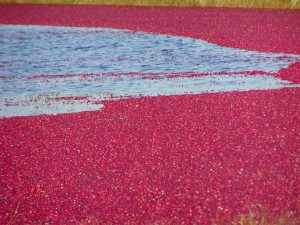 escribe – I think just the combination of berries against the water, with the blue sky and pine forest in the distance. From what little I know about cranberry harvesting, I suspect a machine had gone through this part of the bog earlier in the day to *beat* the cranberries from their vines and the wind in the vast open bog had pushed the berries to one corner where they would later be harvested with the use of a boom to keep them corraled in one place. There is a complicated system of canals and gates to flood and empty each bog as required by the season. Of the twenty or so working bogs that were visible in this one field, only five were completely flooded and three, like this one, yet to be harvested. Most of the others had some water remaining on the margins, and the expected herons, egrets, and waterfowl that one might expect to be there. Of course I have more photos, which Blogger stubbornly won’t allow me to load, but they were mostly meant to give you an idea of the size of a cranberry farm. Very big and windy on a chilly October afternoon.
escribe – I think just the combination of berries against the water, with the blue sky and pine forest in the distance. From what little I know about cranberry harvesting, I suspect a machine had gone through this part of the bog earlier in the day to *beat* the cranberries from their vines and the wind in the vast open bog had pushed the berries to one corner where they would later be harvested with the use of a boom to keep them corraled in one place. There is a complicated system of canals and gates to flood and empty each bog as required by the season. Of the twenty or so working bogs that were visible in this one field, only five were completely flooded and three, like this one, yet to be harvested. Most of the others had some water remaining on the margins, and the expected herons, egrets, and waterfowl that one might expect to be there. Of course I have more photos, which Blogger stubbornly won’t allow me to load, but they were mostly meant to give you an idea of the size of a cranberry farm. Very big and windy on a chilly October afternoon.
It was a nice way to spend a few hours, there was no traffic jam on the way home like last Sunday, and it sure beats grading papers! I’m thinking of going back next Friday for a sunset hayride through the bogs, followed by pinelands songs and stories around a campfire. I’ll at least get back to see the Tundra Swans in February.
Do I want a ninebark?
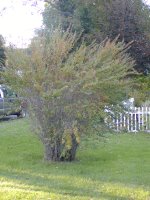 We’ve been looking for a small tree or shrub to replace this old bridalwreath spirea for a few years now. I almost hate to yank it out because it’s been there forever and the mockingbirds sometimes like to nest in it. The center of the shrub is woody and it hardly blooms anymore, so today I went to the nursery around the corner hoping for a bargain. The nursery stock was all 25% off, but I didn’t find anything that grabbed me.
We’ve been looking for a small tree or shrub to replace this old bridalwreath spirea for a few years now. I almost hate to yank it out because it’s been there forever and the mockingbirds sometimes like to nest in it. The center of the shrub is woody and it hardly blooms anymore, so today I went to the nursery around the corner hoping for a bargain. The nursery stock was all 25% off, but I didn’t find anything that grabbed me.
I asked one of the owner’s sons if he might recommend something; he’s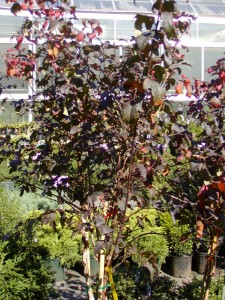 always made good suggestions in the past so I trust his ideas. He suggested I consider this Common Ninebark (Physocarpus opulifolius) pictured at right. I liked the reddish purple foliage and the pinkish white late spring flowers sounded nice. I wasn’t sold on it though, so instead took a few pics to show my husband.
always made good suggestions in the past so I trust his ideas. He suggested I consider this Common Ninebark (Physocarpus opulifolius) pictured at right. I liked the reddish purple foliage and the pinkish white late spring flowers sounded nice. I wasn’t sold on it though, so instead took a few pics to show my husband.
I checked my Manual of Woody Landcape Plants by Michael Dirr to see what he has to say about the Ninebark. From the section on landscape value: “Quite coarse and therefore difficult to use in the small home landscape; limited in usefulness because of rather meager ornamental assets; bark on older stems exfoliates into papery strips exposing a rich brow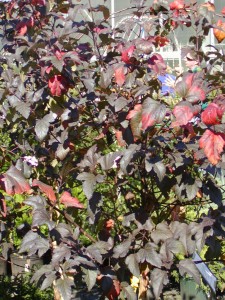 n inner bark; unfortunately, this character is masked by the foliage and dense tangle of stems.” Also, “The Minnesota Landscape Aboretum has a large collection of ninebarks and after looking over the entire group, I still came away with the opinion that about anything is better than a Ninebark.“
n inner bark; unfortunately, this character is masked by the foliage and dense tangle of stems.” Also, “The Minnesota Landscape Aboretum has a large collection of ninebarks and after looking over the entire group, I still came away with the opinion that about anything is better than a Ninebark.“
Well… I guess that answers my question!
Do you have a favorite shrub or smallish tree? Can you suggest something that might be nice as a specimen for full sun in the middle of our back yard? I’d prefer something that blooms and has berries that the birds might find tasty. My husband is inclined to plant a pine, but I want something a bit more showy in such a prominent spot.
From flower to fruit
How innocent were these Trees, that in
Mist-green May, blown by a prospering breeze,
Stood garlanded and gay;
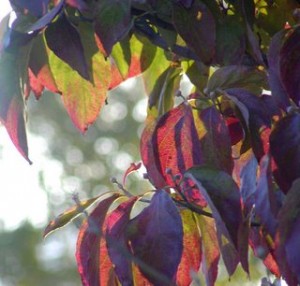 Who now in sundown glow
Who now in sundown glow
Of serious colour clad confront me with their show
As though resigned and sad,Trees, who unwhispering stand umber, bronze, gold;
Pavilioning the land for one grown tired and old;
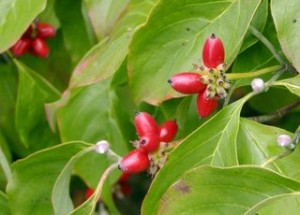
Elm, chestnut, aspen and pine, I am merged in you
Who tell once more in tones of time,
Your foliaged farewell.
– Siegfried Sassoon, October Trees
10/12/06 Mid-week bunny fix
Postcard of a favorite feeder bird
Egret’s Nest asked for a pic of my “favorite easy-to-see bird feeder regular bird” and in response I offer this scanned pic of a white-throated sparrow taken the Christmas after I got my first *real* camera. Like most of my bird pics, it’s not very good, but at least it’s in focus and you can tell what bird it is. I haven’t gotten much better with bird photography in the 5 years since, but I’m still trying. 😉
White-throats are here now; at least I think I’m hearing their lispy call notes, although I haven’t laid eyes on one yet. They are too shy, in all but the worst of winter weather, to come to the feeder nearest the house. Instead I scatter seed for them and the juncos in the back corner of the yard where it borders the scrubby field that shields our yard from the park and athletic fields behind us. They seem to me to be cheerful little birds and not nearly as prone to grumpiness as the song sparrows who are with us year round. I like to hear their “Old Sam Peabody” song and will often whistle along with them.
